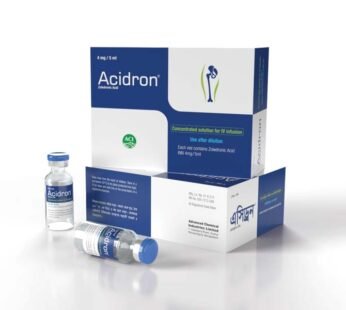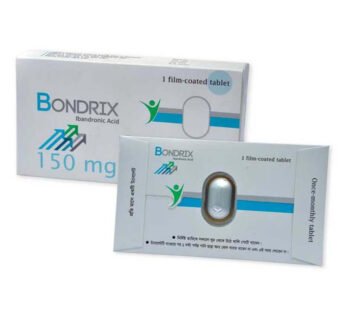Drometa 4 mg/5 ml vial
Description
Indications:
Drometa (Zoledronic Acid) is prescribed for the management of conditions related to bone loss and calcium imbalance. It is indicated for:
- Hypercalcemia associated with malignancy
- Bone metastases in solid tumors
- Osteolytic lesions in multiple myeloma
- Osteoporosis induced by corticosteroids
- Increasing bone mass in men with osteoporosis
- Postmenopausal osteoporosis
- Paget’s disease of bone
- Prevention of postmenopausal osteoporosis
Use only under the guidance of a registered physician.
Pharmacology:
Drometa belongs to the nitrogen-containing bisphosphonate class, primarily acting on bone by inhibiting osteoclast-mediated bone resorption. Its strong affinity for mineralized bone allows for targeted therapeutic effects. Zoledronic Acid’s mechanism of action involves inhibition of the farnesyl pyrophosphate synthase enzyme, leading to reduced bone breakdown. Additionally, it has demonstrated anti-tumor, anti-angiogenic, and pro-apoptotic properties, along with a synergistic effect when used with certain anti-cancer drugs. The compound is rapidly distributed in bone tissue after intravenous administration and is excreted unchanged by the kidneys.
Dosage & Administration:
- Hypercalcemia of Malignancy: A single intravenous dose of 4 mg, infused over at least 15 minutes. A second dose may be considered after 7 days if required.
- Multiple Myeloma & Bone Metastases from Solid Tumors: 4 mg IV infusion every 3-4 weeks. Patients should also take daily supplements of 500 mg calcium and 400 IU vitamin D.
Before administration, dilute the required dose in 100 ml of a calcium-free infusion solution (0.9% sodium chloride or 5% dextrose). The infusion should last no less than 15 minutes. If storage is needed, refrigerate at 2-8°C for no more than 24 hours, ensuring the solution reaches room temperature before use. Do not mix with calcium-containing solutions.
Drug Interactions:
Drometa can be safely used alongside common anticancer drugs, diuretics, antibiotics, and analgesics. However, caution is required when administered with:
- Aminoglycosides, as they may enhance calcium-lowering effects.
- Thalidomide, which may increase the risk of renal dysfunction in multiple myeloma patients.
- Loop diuretics, which heighten the risk of hypocalcemia.
- Other nephrotoxic drugs, requiring careful monitoring of kidney function.
Contraindications:
Drometa should not be used in patients with:
- Hypersensitivity to Zoledronic Acid or other bisphosphonates
- Severe renal impairment (Creatinine Clearance <30 ml/min)
- Pregnancy or breastfeeding
Side Effects:
Common post-infusion reactions include:
- Headache, nausea, fatigue, fever, vomiting
- Flu-like symptoms, bone pain, myalgia, arthralgia
- Hypocalcemia, hypophosphatemia, osteonecrosis of the jaw
Precautions & Warnings:
- Ensure adequate hydration before and after infusion, particularly in elderly patients and those on diuretics.
- Monitor serum calcium, phosphate, magnesium, potassium, and creatinine levels regularly.
- Short-term supplementation may be needed in cases of hypocalcemia, hypophosphatemia, or hypomagnesemia.
- Renal function should be carefully assessed before and during treatment.
Use in Special Populations:
For patients with renal impairment, dosage adjustment is necessary:
- CrCl >60 ml/min: 4 mg (5 ml)
- CrCl 50-60 ml/min: 3.5 mg (4.4 ml)
- CrCl 40-49 ml/min: 3.3 mg (4.1 ml)
- CrCl 30-39 ml/min: 3 mg (3.8 ml)
Overdose Management:
Symptoms of overdose include hypocalcemia, hypophosphatemia, and hypomagnesemia. Treatment involves intravenous supplementation of calcium gluconate, potassium or sodium phosphate, and magnesium sulfate as needed.
Therapeutic Class:
Bisphosphonate preparations
Reconstitution & Storage:
- Dilute in 100 mL of NaCl 0.9% or dextrose 5% before infusion.
- Store below 30°C, away from moisture and light.
- Keep out of reach of children.
Use only as directed by a registered healthcare professional.
Additional information
| Weight | 0.15 g |
|---|









Reviews
There are no reviews yet.